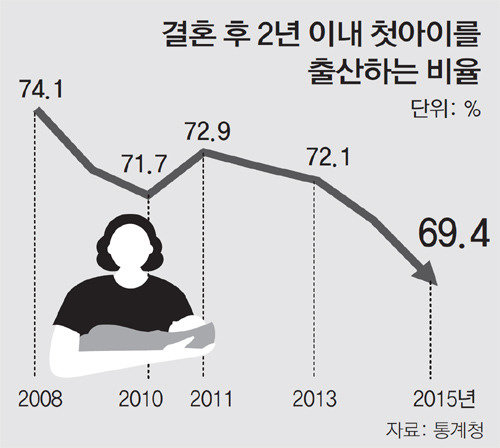Married couples postpone childbirth even after late marriage
Married couples postpone childbirth even after late marriage
Posted August. 25, 2016 06:55,
Updated August. 25, 2016 07:30

According to the 2015 birth statistics released by Statistics Korea on Wednesday, the ratio of women who give birth to their first child within two years after marriage reaches 69.4 percent, a decrease of 1.6 percentage points year-on-year. The rate is the lowest level in 23 years since related data was first compiled in 1993 (82.9 percent). Also, this is the first time the figure fell below the 70 percent level.
The ratio of women who gave birth to their first child two to three years after marriage stood at 21.7 percent, an increase of 1.3 percentage points year-on-year. The ratios of women who gave birth to their first child between four to five years and six to nine years after marriage also increased by 0.2 percentage points and 0.1 percentage points, respectively.
Longer period between marriage and the birth of first child is attributable to an increase in the number of women who have difficulties getting pregnant in tune with a growing number of mothers at higher ages resulting from late marriage. In fact, the average age of mothers who gave childbirth last year stood at 32.2, up 0.2 years from the previous year. Of them, mothers aged 35 or older stood at 23.9 percent, up 2.3 percentage points from the previous year. The fertility rate (number of newborns per 1,000 people in respective age groups) of mothers in their late 30s reached a historic high of 48.3.
“Women who marry at younger ages tend to give birth to their first child immediately, but women who get married later tend to give childbirth at even older ages,” said Lee Ji-yeon, director of the population trend division at Statics Korea.
Meanwhile, due to a hike in the number of mothers who give birth at older ages combined with medical procedures used to expedite pregnancy, the total of numbers of multiple babies per birth is also increasing in tandem. The total number of multiple babies per birth amounted to 16,166 babies last year, up 986 year-on-year. This is about 1.7 times higher than 9,422 babies in 1995.
As the phenomenon in which people get married late and give birth to fewer children has become chronic, Korea will likely have difficulties exiting from a group of countries with ultralow fertility rates. Korea’s crude birthrate (the number of newborns per 1,000 people) reached 8.6 children last year, the lowest level ever. The nation’s total fertility rate (average number of newborns that a woman is expected to give birth during her lifetime) came to 1.24, an increase of 0.03 year-on-year, but was lagging far behind the average (1.68) of the Organization for Economic Cooperation and Development countries.
세종=손영일 기자scud2007@donga.com







